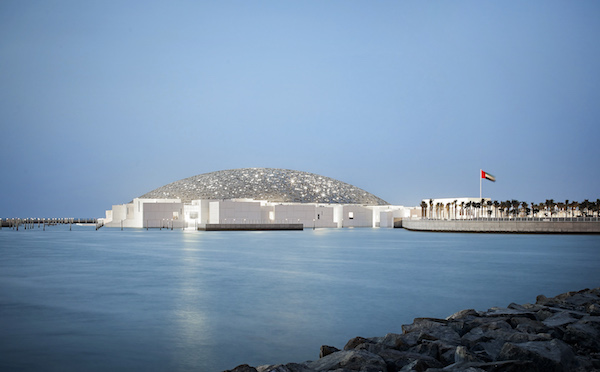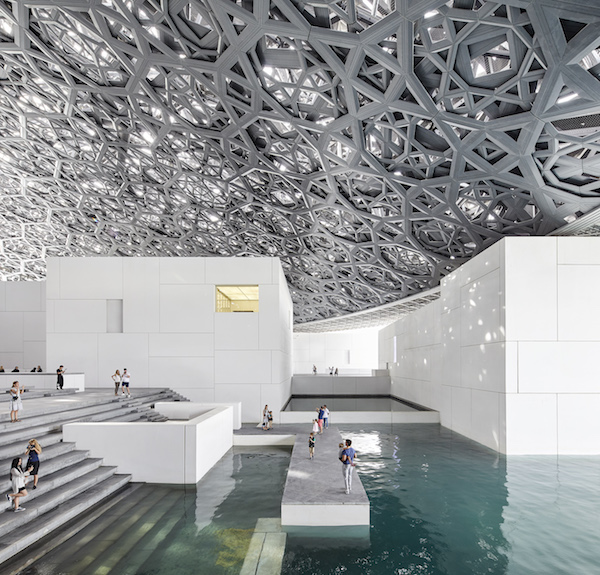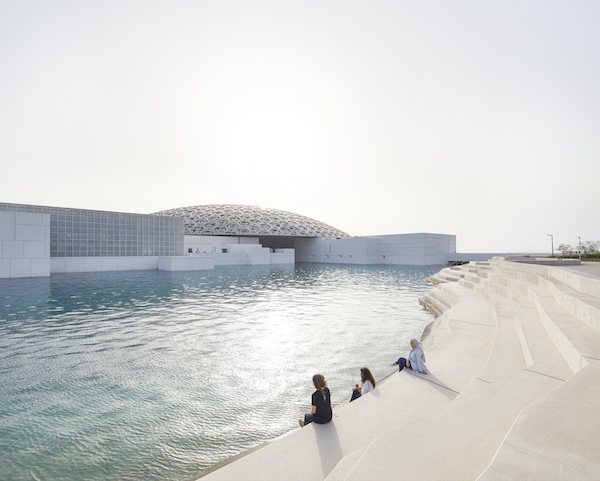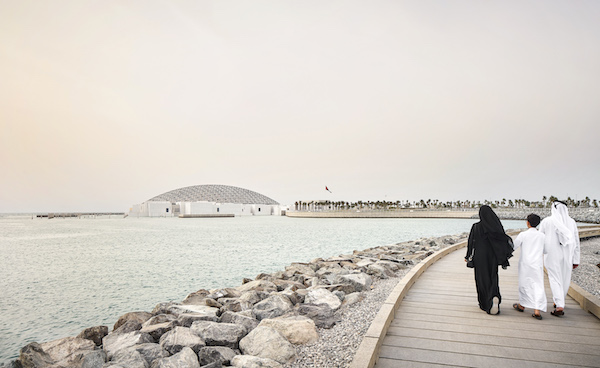INTERVIEW
WITH MANUEL RABATÉ, DIRECTOR OF LOUVRE ABU DHABI
ARTICLE PUBLIÉ LE 14/06/2019
Questions by Anne-Lucie Chaigne-Oudin
Manuel Rabaté has been Director of Louvre Abu Dhabi since 2016
and oversees all aspects of its operations and activity. The institution
welcomed more than one million visitors in its first year, making it the 77th
most visited museum worldwide in 2018. Rabaté has worked on the museum since
its inception, joining Agence France-Muséums a year after the signature of the
intergovernmental agreement between France and Abu Dhabi, first as CFO, then
Secretary General and CEO (2008-2016). Manuel Rabaté was Deputy Director of
Cultural Development (2005-2008) of musée du quai Branly-Jacques Chirac for its
opening, managing the launch of the museum’s first touring exhibitions, notably
Masques - Beauté des Esprits at the Bahrain National Museum. He was Deputy
Director of the auditorium of musée du Louvre (2002-2006), where he participated
in developing new programmes accompanying the creation of the Islamic Art
department. He is a graduate of Sciences Po (1998) and HEC business school
(2001), and a Knight of France’s National Order of Merit.
Louvre
Abu Dhabi was inaugurated on November 11, 2017. Could you please review the
highlights of this first year (exhibitions, acquisitions, loans, etc.) ?
One of our proudest achievements to date is the number and
diversity of our audiences. In 2018 alone, we welcomed more than 1 million
visitors to our museum, not only international tourists but also local
residents, including new art enthusiasts who have not traditionally visited
museums and cultural institutions. The promenade under the dome is a social
space, allowing visitors to stroll and gather. We place our audiences and their
experience at the heart of everything we do and offer.
© Department of Culture and Tourism Abu Dhabi. Photo by
Hufton+Crow.
As part of
our first season A World of Exchanges, we presented four
international exhibitions : Japanese Connections : The Birth
of Modern Décor ; Roads of Arabia : Archaeological Treasures of Saudi
Arabia ; Rembrandt, Vermeer and the Dutch Golden Age : Masterpieces
from the Leiden Collection and the Musée du Louvre ; and Photographs 1842
– 1896 : An Early Album of the World. These exhibitions complement the
displays in our permanent galleries, which include our own collection as well
as loans from French international institutions. In the past 10 years, Louvre
Abu Dhabi has acquired more than 650 masterpieces in accordance with a rigorous
and academic acquisition process. We have leveraged our unprecedented access to
some of the world’s most praised collections, those of our 13 French partner
museums led by musée du Louvre but including also musée d’Orsay, Centre
Pompidou, Bibliothèque Nationale de France, musée Guimet et musée du quai
Branly-Jacques Chirac. These loans enrich our permanent galleries with exquisite
art works and artefacts thanks to the collaboration between the governments of
Abu Dhabi and France.
Additionally, in our first year, the museum catered to the local
community by presenting family-oriented exhibitions and displays in its
Children’s Museum while also undertaking several cooperation projects between
the UAE and France such as CO-LAB, an exhibition showcasing new commissions by
UAE-based artists working with French manufacturers. We are also very proud to
cement the Louvre Abu Dhabi within its ecosystem and to have built
collaborations in the form of additional key loans with UAE museums from all
over the country - Guggenheim Abu Dhabi, Zayed National Museum, Al Ain National
Museum, National Museum of Ras Al Khaimah, and the Department of Culture and
Tourism-Abu Dhabi - and with museums from the Arab world (the Saudi Commission
for Tourism & National Heritage, National Museum – Sultanate of Oman and
Jordan’s Department of Antiquities).
Beyond the galleries, we are also laying the groundwork for a
continuous development in the fields of research and restoration. Safeguarding
our universal cultural heritage is one of our key missions as we expand those
capabilities.
© Department of Culture and Tourism Abu Dhabi. Photo by
Hufton+Crow.
You
mentioned that 1m visitors visited Louvre Abu Dhabi in its first year. Who are
they and what mediation have the museum designed to welcome them ?
Just as the one million mark is significant, the breakdown of our
audiences is even more critical to our mission as a universal museum, with 60
to 70 per cent coming from abroad and 30 to 40 per cent being UAE residents.
The museum is driving tourism to the Emirate and visitors come from all parts
of the globe, including the Middle East, Europe and Asia, with France, Germany,
China, UK, the US, India and GCC being the top visitors. This is an incredibly
important feat for us because it embodies both of our aspirational roles :
first and foremost being a museum for locals which is rooted in the community
and offers multi-purpose and educational spaces ; and secondly a global
institution which contributes to international museography and sits at the
global table.
© Department of Culture and Tourism Abu Dhabi. Photo by
Hufton+Crow.
Creating
unique experiences for visitors is at the heart of everything we do. Not only
through the beauty of the museum’s architecture, but also through the
unprecedented collaborations between the French museum partners and the quality
of the regional and international loans integrated into an existing rich
collection. Our objective is to inspire and engage the next generation of
museum-goers, artists and creatives, from children to young adults and people
of determination. Being inclusive is extremely important to us as a universal
museum, and more relevant than ever with the celebration of the Year of
Tolerance in the UAE in 2019. Through multisensory guides for the hearing and
visually impaired, we strive to make our spaces accessible to everyone. It is a
point of pride for us to witness how these efforts are received, for example
having been chosen as one of many historic landmarks to serve as the location
for the 2019 Special Olympics ’Flame of Hope’ earlier this year.
© Department of Culture and Tourism Abu Dhabi. Photo by
Hufton+Crow.
The museum also welcomes thousands of children and their families
to the Children’s Museum, to learn about the history of the world without
opening textbooks. We also feel very privileged to welcome many Heads of State
and celebrities who carve out the
time in their busy itineraries to visit us at
the museum. We continue to try new things to bring more diverse audiences - for
example we’ve taken artworks from our collection to new members of the public
by installing our critically acclaimed Highway Gallery as the world’s first
roadside gallery, and we organise kayaking tours around the building, offering
participants a guided tour of the museum’s stunning architecture, as seen from
the sea.
In this
region with strong international and cultural ambition, what is your project
for the museum ?
Louvre Abu Dhabi’s vision is to celebrate cross-cultural
connections that transcend geographies and civilisations to see humanity in a
new light. This permeates all aspects of our operations - from curation and
programming to acquisitions and loans and it makes sense for Abu Dhabi, sitting
at a crossroads between East and West, a centre of exchange, which it has
always been. We have many exciting plans for the years ahead and we want to
remain innovative, bold in our vision and relevant to audiences. Thanks to our
strong regional and international collaborations, we have access to some of the
world’s most esteemed cultural institutions and experts to support a year-round
roster of exceptional international exhibitions and programming.
As the first universal museum in the Arab world, we must continue
to develop a voice that resonates with an increasingly globalised audience.
Being a young museum in this region empowers us to try new things. We remain
committed to continually experimenting and changing as the museum grows and our
ideas evolve. The annual rotation of art works in our permanent galleries
allows us to highlight new perspectives and constantly refresh interpretations
of the universal narrative. We will continue to acquire exceptional works based
on the museum’s narrative and with the highest standards of excellence and
academic rigour, to compensate for the decreasing number of loans each year
from our French museum partners.
We will continue to invest in research, whether it be through our
state-of-the-art conservation facilities which is a resource that will
increasingly support the needs of the Arab World, but also researching our
audiences - not only is the museum a destination but in a sense it is a
laboratory for testing new ideas. In addition to research, we continue to
publish books, host international conferences and build the museum’s network
with our peers all over the work.
The imprint Louvre Abu Dhabi has left on the cultural scene since
the agreement was signed in 2007 is remarkable and it is an honour to be a part
of that. In 10 years, the number of degrees related to working in a museum has
increased and we have an impressive wave of Emirati museum professionals working
at the museum – in fact half of our staff are currently UAE nationals. It is
critical that this achievement continues in the coming years. We must also
remain as a leader with a constructive role in the continual growth of the
local cultural scene and artistic ecosystem, supporting what is a great
community of artists, galleries, biennials, fairs and art centres, and offering
opportunities and tools to help creators develop their practice.
Can you
tell us more about the upcoming exhibitions at Louvre Abu Dhabi ?
Following
our successful first season A World of Exchanges, Louvre Abu
Dhabi’s next season, to launch this coming September, Changing Societies, will
present several compelling international exhibitions. In 2019 and 2020, we will
see the following, for which I encourage everyone to mark their
calendars :
Rendezvous
in Paris : Picasso, Chagall, Modigliani & Co (1900-1939)
(September 18, 2019 – December 7, 2019)
Encounter
Picasso, Chagall, Modigliani, Lempicka, Delaunay and 40 of their contemporaries
- visionary artists who came from all over the world to make the French capital
their home. Including approximately 85 masterpieces which are being exhibited
for the first time in the Middle East, Rendezvous in Paris :
Picasso, Chagall, Modigliani & Co (1900-1939) tells the story of
an artistic explosion that inspired some of the most innovative Modern Art of
the early 20th century.
10,000
Years of Luxury (October 30, 2019 – February
18, 2020)
A history of the lavish and the luxurious through 250
extraordinary objects from across the globe – celebrating fashion, jewellery,
art, furniture, design and much more. Marvel at the ways in which luxury has
been interpreted by diverse cultures, with a special emphasis on the prominent
role women have played in its cultural evolution across the millennia. From
extravagant offerings for the divine, to golden furniture fit for a palace, the
exhibition also showcases the iconic couture of fashion houses such as Dior,
Balenciaga and Chanel.
Furusiyya :
The Art of Chivalry between East and West (February
19, 2020 – May 30, 2020)
The
exhibition explores a unique and extraordinary link, where furusiyya in
the East meets Chivalry in the West, and how it led to a specific social class
and culture in the Islamic East and Christian West. Tales of knightly culture
have been told throughout history – of brave heroes fighting for their
sovereign, their religion and their honour ; stories of war, loss,
comradery and courtly love, are told through 130 rare artworks, most of them
seen in the region for the first time. The exhibition is organised by Musée de
Cluny – Musée national du Moyen Âge and curated by Elisabeth Taburet-Delahaye,
Director of Musée de Cluny – Musée national du Moyen Âge ; Carine Juvin,
Curator of Department of Islamic Art, Musée du Louvre and Michel Huynh, Chief
Curator of Musée de Cluny – Musée national du Moyen Âge.
Charlie
Chaplin : When Art Met Cinema (April
15, 2020 – July 18, 2020)
A world first, Charlie Chaplin : When Art Met Cinema,
explores the connection between the great Charlie Chaplin films and the
artistic creations of avant-garde artists of the time, including Marc Chagall,
Man Ray and František Kupka, artists at the centre of modern art movements such
as Cubism, abstract art and Surrealism. Featuring around 150 paintings,
drawings, sculptures, photographs, documents and film scenes, the exhibition
explores Chaplin’s often satirical examination of a rapidly changing world
through ‘The Tramp’ ; the comical and at times controversial character
that made him famous and adored. The exhibition is organised by the Musée
d’arts de Nantes and curated by Claire Lebossé, Curator of the collections of
modern art, Musée d’arts de Nantes.





Aucun commentaire:
Enregistrer un commentaire